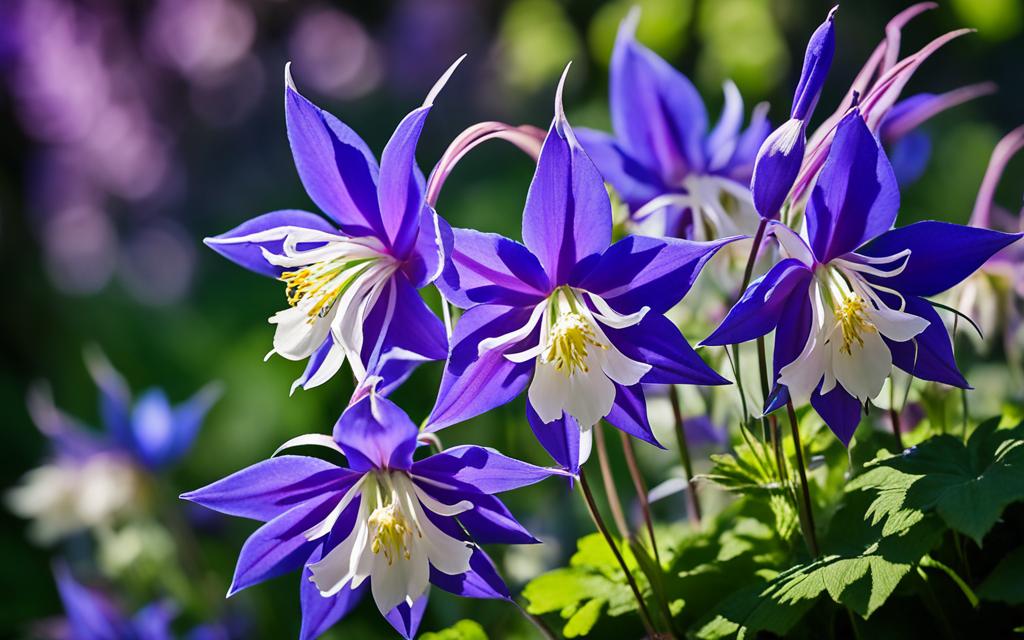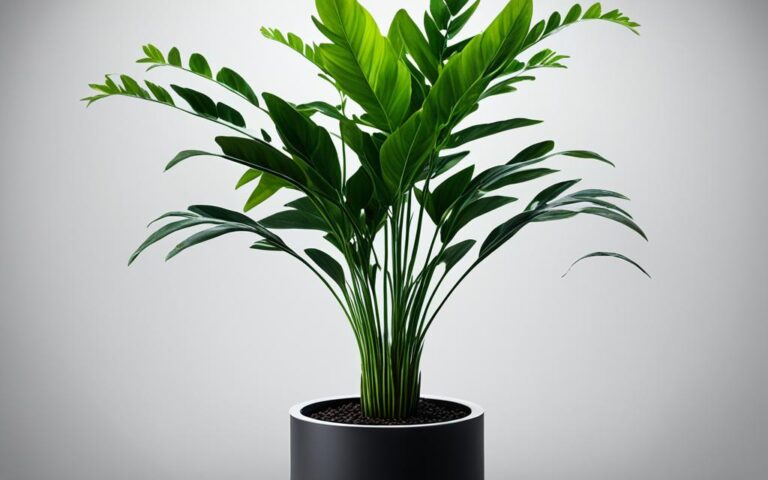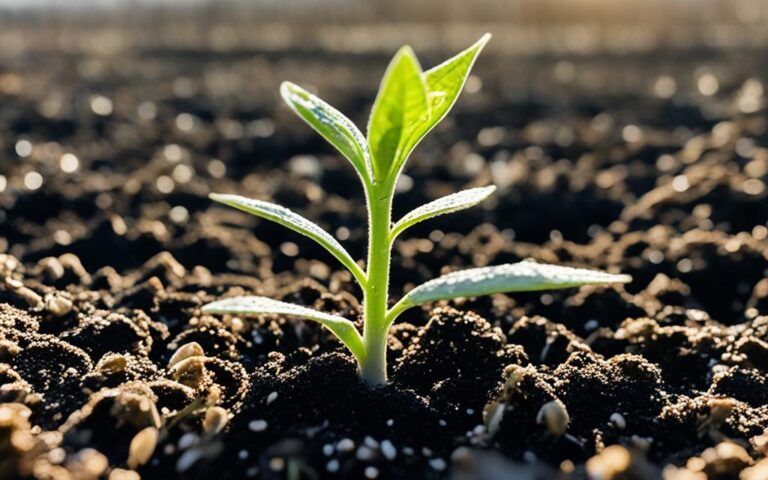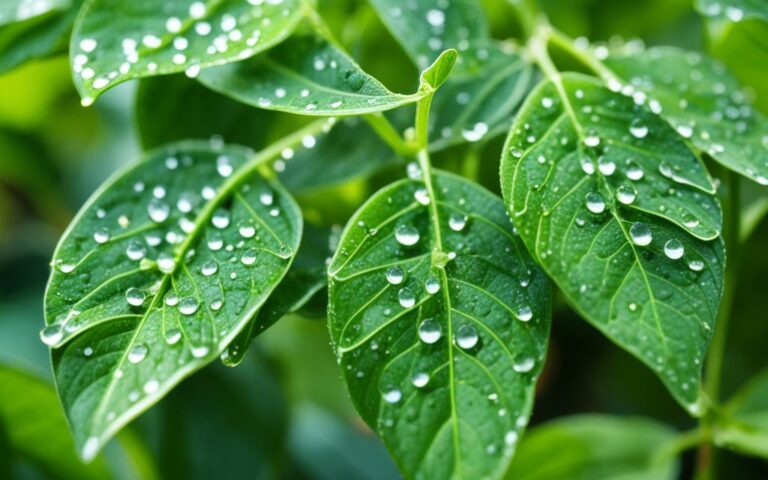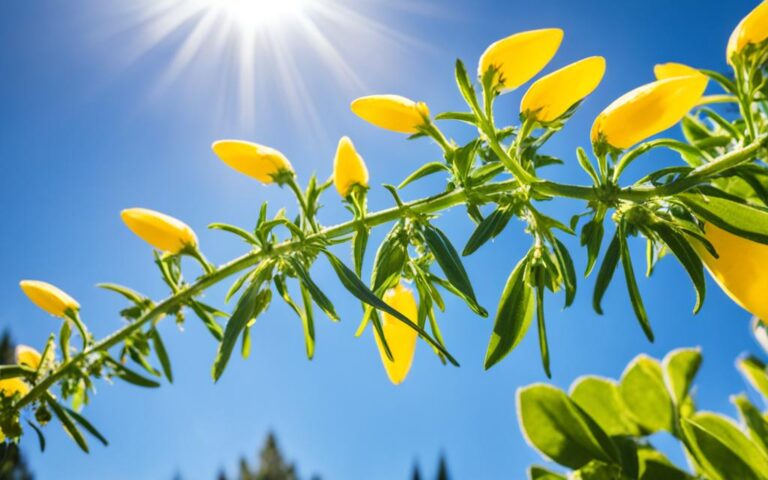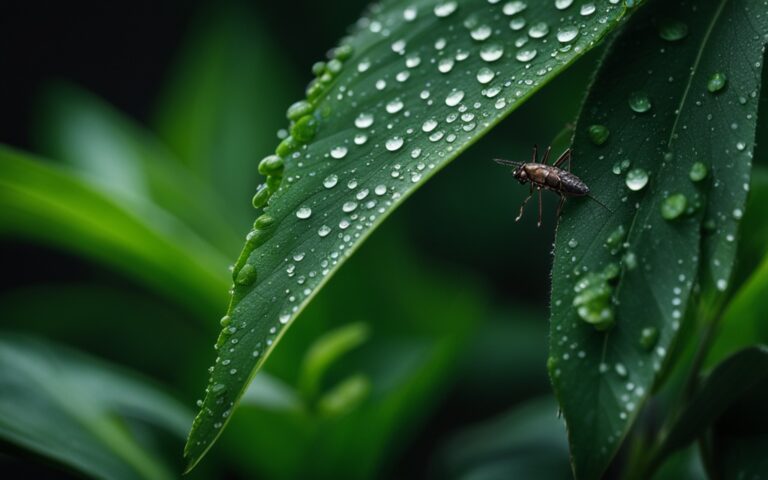Columbine Plant: A Charming Garden Favorite
Did you know there are over 70 types of columbines? These include wild ones found in mountains, by streams, and in woodlands. Known as Aquilegia, these flowers have been in gardens for centuries. They come in many colors and shapes, from tiny to tall plants, adding beauty to any garden.
Columbines are easy to grow and spread on their own. They also draw in hummingbirds and butterflies. Their unique look, with spurred petals and fern-like leaves, makes them perfect for cottage and woodland gardens. They’re a great choice for both new and experienced gardeners.
Key Takeaways
- Columbines come in a wide variety of shapes and sizes, from miniature plants to towering specimens up to 3 feet high.
- The spurs of columbines can extend up to 4 inches in length, adding to their unique and charming appearance.
- Columbines bloom from mid-spring through early summer, making them a favorite for hummingbirds and other pollinators.
- Columbines thrive in moist woodland conditions and are often combined with other ‘high shade’ plants in landscaping.
- Columbines readily self-sow and can be easily started from seed, making them a low-maintenance perennial choice.
Introduction to Columbine Plants
Columbine plants are a favorite in gardens for their unique, nodding flowers that bloom in spring and early summer. These perennials spread easily, forming beautiful drifts in the landscape. They also attract hummingbirds, bees, and butterflies, making gardens more welcoming for wildlife.
Importance and Popularity of Columbine
There are about 100 species of columbines found in North America, Europe, and Asia. They vary in height from 6 inches to 3 feet. These plants come in many colors like blue, purple, white, pink, red, yellow, and brown.
Their flowers have spurred petals that look like an eagle’s claws. The name “Aquilegia” comes from the Latin word for “eagle.” Columbines have been loved by gardeners for centuries for their beauty and charm.
Interesting Facts about Columbine
- Eurasian columbines have shorter and curved spurs, while North American columbines have elongated spurs longer than the flower.
- Columbines were primarily pollinated by moths and hummingbirds before the introduction of domesticated bees.
- The McKana’s Giant strain, a multiple-colored, long-spurred hybrid, was developed by Burpee and won an All-American Selection award in 1955.
- Garden hybrids like the Music series and the Songbird series are popular, with Songbird columbines being about 18 inches tall.
Columbine plants have a long history and still enchant gardeners and nature lovers with their unique beauty and role in nature.
Common Species and Varieties
The columbine plant, also known as Aquilegia, is part of the Ranunculaceae family. It thrives in USDA Hardiness Zones 3 to 9. Gardeners can choose from about 70 species and many hybrids. These flowers can be one to four inches wide and grow from six inches to over three feet tall.
Aquilegia canadensis (Eastern Red Columbine)
Aquilegia canadensis, the Eastern Red Columbine, is native to North America. It has red and yellow flowers with long spurs. This plant can grow two to three feet tall, adding beauty to gardens.
Aquilegia vulgaris (European Columbine)
Aquilegia vulgaris, or the European Columbine, is a popular garden variety. It comes in many colors like pink, purple, and bicolored. This plant grows 14 to 20 inches tall, adding elegance to landscapes.
Aquilegia chrysantha (Golden Columbine)
Aquilegia chrysantha, the Golden Columbine, has bright yellow flowers. It does well in hot, dry areas in the southwestern United States. This variety can grow one to three feet tall, making it a standout plant.
| Columbine Variety | Height | Noteworthy Features |
|---|---|---|
| Aquilegia canadensis (Eastern Red Columbine) | 2-3 feet | Red and yellow flowers with long, slender spurs |
| Aquilegia vulgaris (European Columbine) | 14-20 inches | Wide range of flower colors, including pink, purple, and bicolored |
| Aquilegia chrysantha (Golden Columbine) | 1-3 feet | Bright yellow flowers that thrive in hot, dry conditions |
These are just a few of the many beautiful columbine species and varieties gardeners can choose from. With their diverse colors, sizes, and habits, there’s a columbine for every garden style or preference.
Anatomy of the Columbine Plant
Columbine plants have a unique look, with leaves that look like ferns and flowers shaped like bells. They have columbine leaves that are deeply lobed and soft to the touch. The stems can be short or tall, depending on the type of plant.
Description of Leaves, Stems, and Flowers
The leaves of the columbine plant are a bright green and feel soft and fuzzy. The columbine stems can be short or very tall, changing based on the soil, light, and moisture it gets.
The real highlight of the columbine plant is its beautiful columbine flowers. Each flower has five clawed petals that make a special spurred shape at the back. These columbine spurs can be short or long, making the flowers even more interesting.
Special Features: Spurs and Clawed Petals
The columbine petals are known for their delicate, claw-like shape. This adds to the plant’s unique look. The columbine spurs are important for attracting pollinators like hummingbirds and bees.
| Columbine Plant Anatomy | Key Features |
|---|---|
| Columbine leaves | Deeply lobed, fern-like foliage with a soft, fuzzy texture |
| Columbine stems | Ranging from short and compact to tall and slender, influenced by environmental factors |
| Columbine flowers | Delicate, bell-shaped blooms with five clawed petals forming a spurred shape |
| Columbine spurs | Unique, protruding structures at the back of the flowers, varying in length and curvature |
| Columbine petals | Delicate, claw-like shape contributing to the overall intricate appearance of the blooms |
Columbine Plant Ideal Growing Conditions
Columbine plants have beautiful blooms and unique petals. They do well in cool, moist places and like soil that drains well and is rich in nutrients. Knowing the columbine growing conditions helps keep them healthy and strong in the garden.
Light and Temperature Requirements
Columbine plants prefer full sun to partial shade. In southern gardens, they might need some afternoon shade to avoid the heat. They are hardy in USDA Zones 3-9, making them suitable for many climates.
Soil and Humidity Preferences
These plants like soil that stays moist and is rich in humus. They can grow in average garden soil as long as it drains well. Columbine humidity is also important, as they don’t like dry conditions.
By giving columbine the right amount of light, temperature, soil, and moisture, gardeners can help them thrive. This ensures they stay healthy and look great.
Propagation Methods for Columbine
Columbine plants are easy to spread through different methods. Gardeners can grow more of these lovely flowers. One top way is by using columbine seeds, as these plants spread seeds on their own. These seeds need a cold period, so they do best when sown in the fall or early spring.
If you want to start columbine indoors, you can plant the seeds a few weeks before the last spring frost. This cold period is key for the seeds to grow well.
Another good way to spread columbine is through columbine division. You can split the plant’s clumps and move them to new spots. It’s best to do this in early spring or fall when the plant isn’t blooming. This helps the new plants grow strong and healthy.
- Timing is crucial when harvesting Wild Red Columbine seeds to ensure successful propagation.
- Chill stratification in winter helps mimic nature’s cold snap for seed germination, impacting success rates.
- Hybrid propagation may result in offspring that are not exact replicas of the parent plant, showing variation rates.
- Division propagation in spring or autumn allows for successful plant reproduction during periods of dormancy.
Starting with columbine seed or dividing existing plants makes these perennials easy to spread. They are a great choice for gardeners at any level.
Care and Maintenance
Caring for columbine plants is easy with a few key steps. Cut back the foliage after it blooms to encourage new growth and keep pests like leaf miners away. You can also train columbine to grow up supports or trellises if you want.
Pruning and Training Techniques
Columbine plants are usually pest-free, but leaf miners can sometimes be a problem. These pests leave tracks in the leaves but don’t usually harm the plant much. Cutting off the affected leaves helps control them. Columbine are also pretty resistant to diseases, but they might get powdery mildew or root rot if the soil is too wet. With a little pruning and watching out for pests, columbine are easy to keep up with in your garden.
Common Pests and Diseases
Leaf miner is a pest that can make columbine plants look bad. There’s no spray to kill leaf miners, so just remove the damaged leaves. Columbine sawfly and aphids are other pests that might bother columbine plants.
Gray mold and powdery mildew can also affect columbine plants. These fungal problems need to be treated by removing the affected parts or using fungicides. With the right care, columbine can be a beautiful addition to your garden for many years.
| Pest/Disease | Symptoms | Treatment |
|---|---|---|
| Leaf Miner | Unsightly tracks in leaves | Remove affected leaves |
| Columbine Sawfly | Leaf damage, defoliation | Insecticidal soap or neem oil |
| Aphids | Stunted growth, leaf curling | Insecticidal soap or neem oil |
| Powdery Mildew | White fungal growth on leaves | Fungicidal treatment |
| Gray Mold | Fuzzy gray/brown growth | Remove affected parts, improve air circulation |
Benefits of Growing Columbine Plants
Columbine plants are great for gardeners. They attract hummingbirds, bees, and butterflies, offering them food. The nectar-rich flowers are perfect for hummingbirds, who can reach the deep spurs with their long bills.
These plants also help other wildlife by providing shelter and habitat. The delicate, nodding blooms and fern-like foliage make any garden look beautiful. They fit well in woodlands, cottage gardens, or formal landscapes.
- Attract hummingbirds, bees, and butterflies with nectar-rich flowers
- Provide shelter and habitat for beneficial insects and small wildlife
- Add season-long beauty with delicate, nodding blooms and fern-like foliage
Columbine plants are a great choice for any garden. They support biodiversity and add beauty. Whether you want to attract pollinators or just enjoy the flowers, columbine are a good pick.
“Columbine plants are a beacon for vital pollinators, making them a hub of activity in the garden.”
Columbine in Cottage and Woodland Gardens
Columbine plants are perfect for cottage-style and woodland gardens. They grow well in shady spots and look great with other plants like ferns and bleeding hearts. Their flowers hang down, adding beauty to the soft greenery around them.
In cottage gardens, columbine bring a playful touch. They spread out and grow more plants on their own, filling areas with color. They also work well with spring bulbs and shrubs like azaleas, making the garden look romantic.
Companion Plants for Columbine
Columbine are great for cottage and woodland gardens. They stand out or blend in well with other plants. They look good with ferns, bleeding hearts, foam flowers, spring bulbs, and azaleas.
- Ferns
- Bleeding hearts
- Foam flowers
- Spring-flowering bulbs
- Woodland shrubs (azaleas, rhododendrons)
Columbine plants spread and grow on their own, making gardens look beautiful. They create a lovely mix of colors and textures. This shows off the beauty of columbine cottage gardens and columbine woodland gardens.
“Columbine plants add a touch of whimsy and natural charm to cottage-style and woodland gardens, seamlessly blending with a variety of shade-loving companion plants.”
Columbine Flower Color and Form Diversity
Columbine plants are known for their amazing variety in flower colors and shapes. They come in solid colors like red, yellow, and blue or in delicate mixtures of colors. The shapes of the flowers also vary, from nodding, bell-shaped ones to upright, open ones. Some columbines even have long spurs that look almost otherworldly.
This variety in columbine flower colors and columbine flower forms lets gardeners pick the perfect fit for their garden. Whether you want a simple, single-color type or something more playful with many colors, columbines can add beauty to your garden.
| Columbine Flower Color | Columbine Flower Form |
|---|---|
|
|
“The transformation of petal color from white to blue in the blue columbine is controlled by variation at a single gene.”
The genus Aquilegia has about 70 species across Europe, Asia, and North America. This shows in the columbine flower colors and columbine flower forms available to gardeners. With so many choices, columbines are a great and interesting addition to any garden.
Hybridizing and Surprising Seedlings
Columbine plants love to spread on their own, often surprising gardeners with new colors and shapes. When they cross-pollinate, thanks to insects or wind, they can create new seedlings. These seedlings might have new colors, forms, and traits.
Letting columbine plants spread naturally can lead to unique hybrids. These new plants can look different from the originals. This surprise is what makes growing columbine so exciting. Every season, you might see new and interesting plants.
Some gardeners also try to mix different columbine types on purpose. They aim to create new colors and shapes. Whether it happens by accident or on purpose, columbine seedlings keep surprising and pleasing gardeners.
“The process of collecting columbine seeds involves identifying ripe pods by their brown color, which indicates mature seeds ready for harvesting.”
- Columbine plants come in many colors thanks to mixing different types. This makes them great for various garden themes.
- These plants easily mix with each other, leading to new kinds through the help of pollinators.
- The seed pods of columbines have a special shape to show off the seeds inside. When they’re fully ripe, they make a rattling sound.
Whether you let columbine plants spread on their own or mix them on purpose, the possibilities for new and interesting seedlings are endless. These plants keep gardeners excited and amazed for many years.
Obtaining Unusual Columbine Varieties
Common columbine varieties are easy to find at local nurseries. But, if you want something more unique or rare, you’ll need to look elsewhere. Online seed companies like Swallowtail Garden Seeds and Plant World Seeds have a great selection of unusual columbine. They offer dwarf alpine types, vibrant bicolors, and even the golden Aquilegia chrysantha.
By researching and ordering from these specialty suppliers, gardeners can grow more unusual columbines. These rare columbine rare varieties can make your garden stand out. They come in dramatic colors and unique shapes, adding surprise and joy to your garden.
Seed Sources for Rare Columbine Cultivars
For unique columbine seed sources, check out these online retailers:
- Swallowtail Garden Seeds
- Plant World Seeds
- Rare Roots
- High Country Gardens
- Seed Savers Exchange
These columbine seed sources offer a wide range of rare and specialty columbine varieties. Whether you want unique colors, interesting shapes, or hard-to-find species, these online stores have you covered. They let you create a truly unique columbine collection.
Naturalized Columbine in Wild Settings
Columbine plants love to spread and form beautiful drifts in wild areas. In North America, Aquilegia canadensis (Eastern Red Columbine) and Aquilegia caerulea (Rocky Mountain Columbine) cover forest floors and rocky spots. They grow well in semi-shaded, moist places thanks to their ability to self-seed.
Gardeners can create a natural look by letting columbine plants spread on their own. This makes the garden look more natural and charming. Whether in a cottage garden or a woodland area, naturalized columbine bring a romantic touch to the space.
| Columbine Characteristics | Wild Columbine | Cultivated Varieties |
|---|---|---|
| Height | 1 to 2 feet | 30 inches on average |
| Flower Size | Smaller, 3-4 inches | Larger, 3-4 inches |
| Flower Orientation | Downward-facing | Upward-facing |
| Bloom Time | Primarily spring | Spring through summer |
| Planting Needs | Mass planting for visual impact | Individually or in small groups |
Aquilegia canadensis, also known as Canadian Columbine and Eastern Red Columbine, can be found growing wild in southwestern Ontario. It’s hardy in zones 3 to 8, making it adaptable to many climates. You can also find Aquilegia varieties from Europe, like Aquilegia vulgaris, which also do well in zones 3 to 8.
Adding columbine in the wild to your garden can make it feel more magical and natural. Whether you’re going for a woodland look or a more manicured border, these plants bring beauty and whimsy.
Interesting Cultivars and Their Origins
There are many fascinating cultivars of columbine, each with its own story. One example is the ‘Corbett’ columbine. It was found growing wild in a Maryland backyard. It was shared with neighbors and then spread to nurseries, becoming known to more gardeners.
‘Corbett’ columbine stands out with its short size and bright lemon-yellow flowers. The McKanna hybrids are known for their long spurs. The Winky series has double-flowered blooms that face up. These columbine cultivars bring more beauty and variety to gardens.
‘Corbett’ Columbine’s Unique History
The ‘Corbett’ columbine has an interesting story. It was first seen in a Maryland backyard. The homeowner shared it with others, who loved its lemon-yellow flowers and compact size.
Soon, ‘Corbett’ columbine was in nurseries across the country. It became a popular choice for gardeners, adding a new beauty to the columbine family.
“The ‘Corbett’ columbine, with its lemon-yellow flowers and tidy, compact growth, is a true garden gem that almost seems too good to be true – the product of humble backyard origins that have blossomed into widespread popularity.”
Using Columbine in Landscape Design
Columbine plants are versatile and fit well in many garden styles. They have delicate blooms and fern-like leaves. This makes them perfect for cottage, woodland, and naturalistic gardens. They can spread on their own, adding beauty without much work.
In formal gardens, columbine add depth with layered borders. They come in many colors and shapes. This lets gardeners create unique looks throughout the season.
The Swan series has bright, two-colored flowers. The native Aquilegia canadensis has delicate, hanging blooms. Columbine can make any columbine landscape design or columbine garden design more beautiful.
Columbine plants can be the main attraction or blend into a garden. Their tall, slender shape works well with other plants. They add elegance and a bit of magic to gardens.
“The spur on each columbine flower is compared to an eagle’s claw and aids in attracting pollinators.”
Columbine attract hummingbirds, butterflies, and other pollinators. Adding them to your garden makes it a haven for wildlife. It also creates a magical place for you to enjoy.
Whether you want a cottage garden, a woodland area, or a formal garden, columbine are a great choice. They bring color, texture, and beauty to your columbine landscape design or columbine garden design. These flowers are sure to become a favorite in any garden.
Conclusion
Columbine plants are a favorite in gardens across the United States. They attract pollinators and provide homes for wildlife. They also add a romantic touch to many garden styles.
The Eastern Red Columbine has bold, spurred flowers. Rare and unique columbines can be found through specialty seed sources. This shows how diverse columbines are.
Columbine plants are easy to care for and can grow on their own. They are perfect for both new and experienced gardeners. These plants can be the main attraction, a background, or part of a woodland garden.
As gardeners keep discovering the beauty of columbines, they will continue to be a key part of American gardens. Their lasting appeal and value show how much they are loved.
In conclusion, columbine plants are a treasured part of gardens everywhere. They bring beauty, versatility, and importance to the environment. As gardeners learn more about these perennials, the columbine’s legacy will live on for many years.
